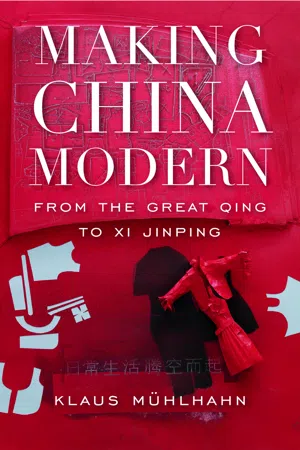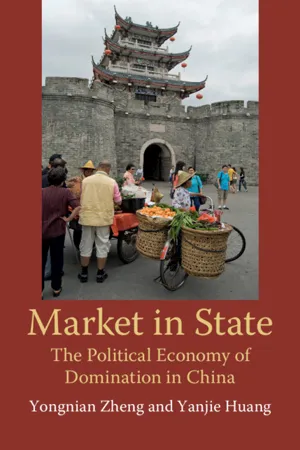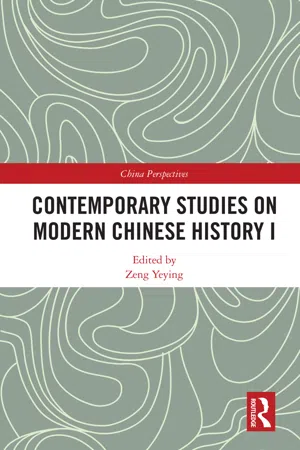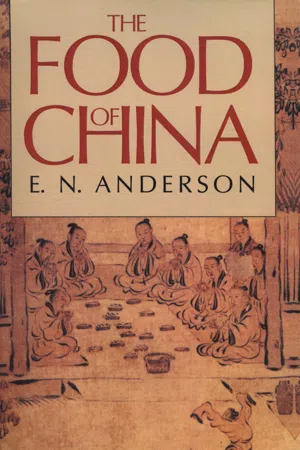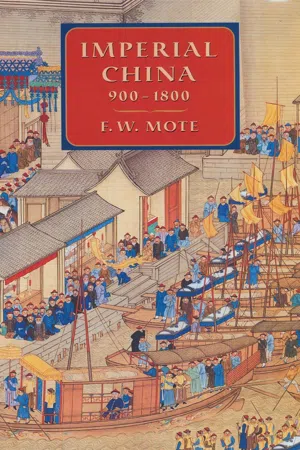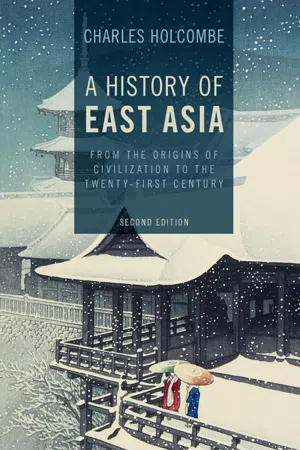History
Late Imperial China
Late Imperial China refers to the period from the Ming dynasty to the end of the Qing dynasty, spanning from the 14th to the early 20th century. This era was characterized by centralized imperial rule, economic growth, cultural flourishing, and significant social and political changes. It also saw the rise of European influence and the decline of the traditional Confucian-based social order.
Written by Perlego with AI-assistance
Related key terms
1 of 5
10 Key excerpts on "Late Imperial China"
- eBook - PDF
China
A New History, Second Enlarged Edition
- John King Fairbank, Merle Goldman, Merle Goldman(Authors)
- 2009(Publication Date)
- Belknap Press(Publisher)
P A R T T W O Late Imperial China 1600–1911 L ate imperial china from 1600 to 1911 saw a doubling if not actually a tripling of population and a corresponding growth in production and trade and the institutions that sup-port them. The disorder of the seventeenth-century transition from Ming to Qing dynastic rule was followed by a High Qing period from about 1680 to the early nineteenth century. Only after ca. 1820 did Western contact begin to get out of control. By that time the decline of the Qing dynasty had already begun. In this dramatic story of material growth and political decay the autocratic state maintained in theory its claim to dominate all as-pects of Chinese life, but in fact it played a minor part in the dy-namic growth of Chinese economy and society of Late Ming and Qing. In Part Two our main interest therefore shifts from politics to economics, from the state to the society. The old Victorian stereotype of a China that remained passive and unchanging while the progressive West exploded over the globe is long since out of date. Instead we have to imagine as of 1750 an Asia of big countries—Japan at 28 million was larger than France or Germany, while both China at, say, 200 million and In-dia at perhaps 100 million were much bigger still. Europe was merely a peninsula of the Eurasian land mass, crowded between the Mediterranean and Baltic Seas. The Americas had perhaps 10 million Native Americans, while the European element consisted mainly of settlements up the St. Lawrence River and along the At-lantic and Gulf coasts, in addition to the older Iberian settlements of Mexico and Central and South America. Thus a mere 250 years 163 ago the world population was distributed much differently than to-day. After about 1750 the Industrial Revolution brought a great in-crease in the use of steam in manufacturing and transport. Its auto-motive, electronic, and other successors have remade the human condition worldwide. - eBook - ePub
- Gregory C. Chow, Dwight H. Perkins(Authors)
- 2014(Publication Date)
- Taylor & Francis(Publisher)
2THE LATE QING DYNASTY TO THE EARLY REPUBLIC OF CHINAA period of great institutional transformation 1Kenneth S. ChanIn the period from the late Qing dynasty until the Republic of China, a far-reaching transformation in the social institutions of China took place. The traditional institutions and social values in the late Qing dynasty were unable to bring China out from the Malthusian trap into modern economic growth. Above all, it was the wars with – and defeats from – the imperialist nations that had brought China to this great institutional transformation. This chapter summarizes China’s response to the changing external environment in the Qing dynasty (the Republic of China) which was then under highly rigid and centralized (highly de centralized) institutions. Economic progress was observed in the early period of the Republic although, as the nation was fragmented, it never reached its full potential.Introduction
During the transition from the Tang to the Song dynasty in China, a major transformation of the social institution had taken place, in which China moved from a highly aristocratic society to a more populist society.2 The social values, such as cultural norms, social customs, and beliefs, also went through a sea change. However, an even more significant institutional transformation in China occurred in the period from late Qing to the Republic of China. This transformation had much more far-reaching implications than the one during the Tang–Song transition. The economic and social impact of the Qing–Republic institutional transformation will be the main focus of this chapter.This chapter is organized as follows. Section 1 summarizes some relevant theoretical economic models from the literature together with their predictions. By and large, these predictions receive support from the historical events. Section 2 describes the changing external environment and the economy in the Qing dynasty, governed under a highly centralized institution. Section 3 describes those in the Republic of China period when China was under a highly decentralized institution. Economic progress was observed in the period of the Republic, although it never reached its full potential, as the nation was fragmented (Rawski 1989). Section 4 sketches a version of the Malthusian and modern growth model that is relevant for the Chinese economy in this period. Section 5 - eBook - PDF
Making China Modern
From the Great Qing to Xi Jinping
- Klaus Mühlhahn(Author)
- 2019(Publication Date)
- Belknap Press(Publisher)
Intense discussions of how to make China strong and wealthy again marked a piv-otal moment in the creation of a distinctively modern Chinese national identity, defined above all in nationalistic and military terms. These ideas laid the foundations for the painful convulsions and political revolutions of the twentieth century. ( 25 ) ONE Age of Glory 1644–1800 The Qianlong emperor’s inspection tour of 1751 fell into a period representing the zenith of imperial splendor, a time of cultural efflorescence, economic power, and military expansion. Historians sometimes call this period the “High Qing,” referring to its status as the peak, the last pinnacle of an impe-rial history lasting almost two millennia. The Qing dynasty ran an empire that in many respects was “modern” (although the term was not used in China before the end of the nineteenth century) even before China’s encounter with the “modern” West. At its core was a set of efficient institutions that allowed the Qing to promote economy, engage in border-crossing interactions, cede space to local governance, and maintain an imperial bureaucracy of light so-cietal penetration. The civil service examination systems enabled broad elite participation in governance on the basis of achieved merit rather than inher-ited birthright. The vibrant Qing market institutions were neither stagnant nor a closed system.1 In fact, they were deeply integrated into the world’s economy through trade, and allowed many foreign goods, techniques, and even decors to circulate among the imperial elites. Vibrant and open intel-lectual discussions were emerging that advocated evidence-based and precise scientific inquiry. The Chinese empire was also the dominant power in East Asia. It was at the center of a web of peaceful relations managed through the tribute system. - eBook - PDF
Market in State
The Political Economy of Domination in China
- Yongnian Zheng, Yanjie Huang(Authors)
- 2018(Publication Date)
- Cambridge University Press(Publisher)
The contemporary Chinese planned and market economy can easily find predecessors, especially in the late imperial iteration. Before dipping into its changing forms, we shall make some observations regarding the enduring features of the imperial political economy in terms of state–market relations. As an agrarian empire, imperial China’s political economy consistently featured the uneasy coexistence of subsistent farming households, naturally formed grassroots and local markets, and the fiscal institutions of the coercive state built around the imperial household and a complex bureau- cracy. 4 Such coexistence was secured on the premise that the imperial state could hold its disruptive social and economic dynamics within limits while at the same time sustaining a stable tax base. Such a pattern could be 4 There is a large growing body of literature on the economic history of imperial China. The long-run political economy of Late Imperial China was clouded by methodological and ideological debates: see Albert Feuerwerker, Chinese Social and Economic History: From the Song to 1900: Report of the American Delegation to a Sino-American Symposium on Chinese Social and Economic History (Ann Arbor, MI: The Center for Chinese Studies, University of Michigan, 1982). In the 1980s, the Chinese Academy of Social Sciences published the history of capitalistic development in Late Imperial China: see Xu Dixin and Wu Chengming, translated by Li Zhengde, Liang Miaoru, and Li Siping, edited and annotated by C. A. Curwen, Chinese Capitalism, 1522–1840 (New York, NY: Saint Martin’s Press, 2000). The most comprehensive compilation by Chinese scholars in recent years is the nineteen-volume series Zhongguo Jingji Tongshi (A General Economic History of China) (Beijing: The Economic Daily Press, 2005). A general empirical economic history for various dynasties of imperial China was available in the various volumes of the Cambridge History of China. - eBook - ePub
- Zeng Yeying(Author)
- 2020(Publication Date)
- Taylor & Francis(Publisher)
3 The political history of the late Qing Dynasty ZENG Yeying and JIANG TaoThe political history of the late Qing Dynasty is an important part of modern Chinese history. As “modern times” itself is a relative concept, with the passage of time, the time range of modern Chinese history has changed greatly in the past 60 years.In the 1950s, modern Chinese history basically refers to the period of time from the Opium War in 1840 to the May 4th Movement in 1919. Today, in the twenty-first century, people who study modern Chinese history have recognized that the period from 1840 to the founding of the People’s Republic of China in 1949 should be placed within the scope of modern history. However, the late Qing Dynasty (from the Opium War in 1840 to the abdication of the Qing emperor in 1912) remains unchanged in modern times, and the political history of the late Qing Dynasty has always been an important part of modern Chinese history.For the study of the political history of the late Qing Dynasty in the past 60 years, this chapter takes the reform and opening up in 1978 and the beginning of the new century in 2000 as the boundaries and roughly divides it into three stages around 1978 and the beginning of the twenty-first century for a brief account.3.1 A new system in formation
The period between 1949 and 1978, especially the 17 years from 1949 to 1966, is the formation period of the new modern history system. In the period the study, the political history of the late Qing Dynasty was included in the framework of the new system of modern Chinese history, and fruitful results had been achieved.The founding of the people’s Republic of China is the victory of the Communist Party of China, the victory of the Chinese people, and the final result of nearly a hundred years of turmoil and transformation in old disaster-ridden China. The national ideology inevitably became the guiding principle for the study of modern Chinese history since the late Qing Dynasty, and the study of relevant history also made an indissoluble bond with politics. - eBook - PDF
- Ellen G. Landau(Author)
- 2007(Publication Date)
- Yale University Press(Publisher)
Involution Late Imperial China The Ming Dynasty: Autocracy and Slowdown The Ming rulers have been blamed for failing to lead China to capitalism and industry, because the West developed these dubious blessings during the same period. A leading Western authority on Ming agriculture, Evelyn Sakakida Rawski, wrote: The economic landscape of Ming China is most commonly studied not for itself but as a reference point in larger interpretations of Chinese history. Modern preoccupations, in particular with the "failure" of China to respond as did Japan to Western "impact," have shaped the nature and content of research, so that much of the scholarship on Chinese economic history in the Ming and Ch'ing periods . . . reveals a Europo-centric bias in its focus on why China did not independently sustain an Industrial Revolution. (1972:1) The Ming sovereigns might have replied that they were having enough trouble trying to be imperial dragons for everyone to blame them for not being savage tigers too. (On Ming history, see Chan 1982, which follows the official histories too faithfully; Farmer 1976; Hartwell 1982; Huang 1974, 1981; Hucker 1961, 1978; Spence and Wills 1979. Historical material in this chapter is synthesized primarily from these sources.) Incompetence, corruption, and abject failure characterized much of the Ming period and helped prevent China from making major breakthroughs in science and technology. Still, the Ming Dynasty lasted for almost three hundred years, most of which were more peaceful and prosperous by Chi- nese standards. Population grew more than at any previous time in China's history, there were no significant wars, and external threats were effectively met until the very end. 94 6 Involution 95 The strengths and weaknesses of Ming stem from the policy of its found- er. Chu Yuan-chang was a phenomenon never seen before in China and rarely in any country: a man from the very lowest orders who took over the country. - eBook - PDF
- Conrad Schirokauer, Miranda Brown(Authors)
- 2012(Publication Date)
- Cengage Learning EMEA(Publisher)
Late Ming Government (1590–1644) A conspicuous feature of the last fifty years of the dynasty was the inadequacy of its emperors. When Zhang Juzheng died in 1582, Emperor Shenzong, then not quite nineteen, determined that during his reign no minister would again Copyright 201 Cengage Learning. All Rights Reserved. May not be copied, scanned, or duplicated, in whole or in part. Due to electronic rights, some third party content may be suppressed from the eBook and/or eChapter(s). Editorial review has deemed that any suppressed content does not materially affect the overall learning experience. Cengage Learning reserves the right to remove additional content at any time if subsequent rights restrictions require it. Chapter 8 ■ The Ming Dynasty: 1368–1644 203 FIGURE 8.4 Dong Quichang, The Qingbian Mountain. Hanging scroll, ink on paper, dated 1617. 26.38 in. × 88.58 in. Natural forms are tilted, compressed, and juxtaposed not to represent nature but to emphasize the painting’s formal organization and the interplay of light and dark. © Cleveland Museum of Art, 2003. Leonard C. Hanna, Jr. Bequest, 1980.10 Copyright 201 Cengage Learning. All Rights Reserved. May not be copied, scanned, or duplicated, in whole or in part. Due to electronic rights, some third party content may be suppressed from the eBook and/or eChapter(s). Editorial review has deemed that any suppressed content does not materially affect the overall learning experience. Cengage Learning reserves the right to remove additional content at any time if subsequent rights restrictions require it. 204 Part Three ■ Late Imperial/Early Modern Period FIGURE 8.5 Wu Bin landscape. Hanging scroll, ink and light color on paper, 38.78 in. - eBook - ePub
- F. W. Mote(Author)
- 2003(Publication Date)
- Harvard University Press(Publisher)
To be sure, the emperor, court, and central administration exerted very strong influence over the conduct of government throughout the realm, could control the official lives of the elite sector of society, and quite obviously held the decision-making power in policy matters. Yet there was much more to Chinese government, and to the lives of people throughout all of Chinese society. For all the dark shadows, the age of “High Qing” (as the eighteenth century has been dubbed) also has been painted in glowing colors: “It was an age of superlatives—the last brilliant epoch of the old Chinese imperial order.” 52 The descriptive information supporting that kind of generalization ranges from the elegant lives of the cultured elite, to the evidence for great wealth of cities throughout the realm, to the order and relative prosperity evident in much of the life of ordinary society. By the end of the Qianlong reign, the Qing state nevertheless faced many serious problems. The fiscal soundness of the later Qianlong reign period was undermined by military expenses (inflated by corrupt practices of military leaders), and by the inroads of insatiable civil officials led by the example of Heshen; the government began to run short of funds. A stodgy complacency affected the conduct of regional and local administration. Civil governing lagged behind changing social conditions. The aging ruler lost the discernment or the will to make the governing decisions that would have kept the machinery working better. Focused on enhancing the Manchu nobility’s status in society, he tolerated outrageous malpractice. In the view of his son and an impatient group of reform-minded officials, both Chinese and Manchus, the Qianlong emperor simply lived too long. He became more obstinate by the year. His son’s accession, when at last his father took up his symbolic retirement in 1796, was a frustrating sham that prolonged the emperor’s powers to reign - eBook - PDF
- Hui Wang, Wang Hui, Michael Gibbs Hill(Authors)
- 2014(Publication Date)
- Harvard University Press(Publisher)
Looking at the larger trends, however, this type of multipolar state of affairs was not at all stable. Beginning in the seventeenth cen-tury, the process of empire building contained tensions between forces for diversity and uniformity, but the process toward the convergence of systems was nonetheless a long-term trend. The multiple centers of impe-rial power were expressed in two major ways: first, in areas occupied by Han Chinese, the Qing government continued to employ the version of China’s Modern Identity and the Transformation of Empire 125 centralized administration ( junxian) used during the Ming dynasty. In these areas, the central government held absolute authority, but this au-thority did not penetrate into the foundational level of society, as patrilin-eal clans and rural gentry continued to play extremely important roles throughout the Qing. 23 Second, during the Qing, the order of subordina-tion and relationship of lord and vassal (chenfu guanxi) between the em-peror on the one hand and Mongolia, Tibet, Xinjiang, and southwestern tribal states on the other was established within a multicentered frame-work of power, in which the former (the emperor) had no right to inter-fere directly in the latter’s internal affairs. At the same time, the latter could maintain their own unique laws, religious faiths, and right to self- determination. The disintegration of the patrilineal clans and rural gen-try is even more closely related to the Taiping Rebellion and modern nation-building movements in the nineteenth century. - eBook - PDF
A History of East Asia
From the Origins of Civilization to the Twenty-First Century
- Charles Holcombe(Author)
- 2017(Publication Date)
- Cambridge University Press(Publisher)
This, too, helps explain why late imperial Chinese society was exceptionally stable. The ethical values that were spread by this pervasive education were not always necessarily ones of which we might approve today. For example, the renewed emphasis on the study of the Confucian Classics is sometimes blamed for a perceptible deterioration in the status of women. It would actually be a little unfair to blame Neo-Confucian moralists for the foot-binding fashion that just happened to begin spreading in Song times, and the late imperial spread of the ideal of the chaste widow may have been due in part to a Chinese reaction to the peculiar circumstances of Mongol rule in the fourteenth century. But, nonetheless, Neo- Confucianism did reaffirm patrilineal principles and patriarchal ideals such as the chaste widow and gender separation. The Neo-Confucian revival may have con- tributed to a hardening of patriarchal attitudes in Late Imperial China. 18 Neo-Confucianism The economic prosperity of the Song Dynasty coincided, unsurprisingly, with a period of great cultural vitality, both in the realm of popular street culture and in the fine arts. Chinese painting, for example, reached a level of exquisite perfection in the Song Dynasty that has never been surpassed, though it may sometimes have been equaled (see Figure 5.2). The most important intellectual development during the Song Dynasty was undoubtedly the great Confucian revival we call Neo-Confucianism. The Neo-Confucian movement grew out of the late Tang, matured in the Song, and continued to dominate East Asian higher culture until the early twentieth century. Though “Neo-Confucianism” is a convenient English label for this broad movement, there was actually no single Chinese name for it, and the Chinese tended to perceive it instead in terms of multiple schools associated with individual scholars or groups of scholars.
Index pages curate the most relevant extracts from our library of academic textbooks. They’ve been created using an in-house natural language model (NLM), each adding context and meaning to key research topics.


